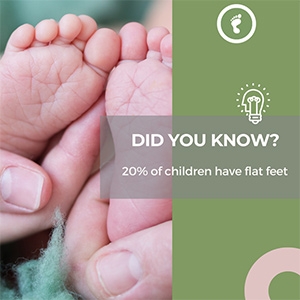Flat feet in children is a condition that has been a source of concern for parents for many years. Some believe that it can lead to problems later in life, while others believe that it is simply a cosmetic issue. So, what is the truth?
We usually do not develop arches until around age three or four, and sometimes the arch won't be detectable until first grade. Instead, young kids have a large pad of fat where the arch would normally be, which protects their feet from injury.
In some cases, kids never develop that arch and need to be evaluated by a podiatrist to avoid future problems. It might be that there are problems with the hip or knee. Sometimes the foot bones are joined together and can't move, which is painful.
There is no denying that flat feet can be a source of pain and discomfort. If your child has flat feet, you may notice that they complain of foot pain more often than other children. They may also have difficulty participating in activities that involve running or jumping.
There are several treatments available for flat feet in children including:
- Wearing a heel cup
Heel cups work by providing support and cushioning for the heel, which can help to improve foot function and alleviate pain. Plus, they're relatively inexpensive and easy to find!
- Shoe inserts or orthotics
Orthotics not only do they provide support and help relieve pain, but they can also improve alignment and prevent further problems down the road.
There are two main types of orthotics: custom-made and over-the-counter. Custom-made orthotics are made specifically for each child, based on a mold or cast of their feet. Custom orthotics are great to teenagers because it will provide their feet with the most correction
We usually don’t recommend custom orthotics for young children because they will outgrow them too quickly. Instead, for younger kids, we recommend Littlesteps or Quadrasteps. These are over-the-counter inserts that we fit to your child based on their specific foot type. These inserts provide great correction and are easier to replace for your fast-growing kiddos.
- Wearing more supportive shoes
Supportive shoes provide arch support and help to distribute weight evenly across the foot. This can help to reduce pain and prevent injuries.
There are a variety of different types of supportive shoes available for children with flat feet. Some shoes are designed for specific activities, such as running or walking. Others are general purpose shoes that can be used for a variety of activities. Choosing the right type of shoe is important to ensure that it provides the right level of support. We recommend parents to check out Howard Curry Shoes. They have a wide selection of shoes and the staff is very knowledgeable.
Bonus! If you tell Howard Curry that we sent you, you can get 5% off!
- Special exercises
Stretching can be a helpful way to reduce pain and improve flexibility in the feet.
There are a variety of stretches that can be helpful for flat feet. One stretch that is often recommended is the “towel stretch.” To do this stretch, place a towel on the floor and sit with your feet on either end of the towel. Slowly pull the towel toward you, using your toes to grip the fabric. You should feel a stretch in the arch of your foot. Hold the stretch for 30 seconds and repeat 3 times.
Another helpful stretch is the “toe raise.” To do this stretch, stand with your feet hip-width apart and place your hands on your hips. Raise up onto your toes and hold for 3 seconds. Slowly lower back down to the starting position. Repeat 10 times.
Check out our step-by-step stretching guide!
- Resting to relieve the pain
Rest is important for children with flat feet because it helps to promote the healing process and prevent further injury. It also helps to relieve pain and swelling. Children with flat feet should avoid activities that put stress on their feet, such as running and jumping. Instead, they should focus on activities that help strengthen the muscles and ligaments around their feet, such as swimming and biking.
The verdict is in and it’s good news for parents of kiddos with flat feet – having them doesn’t mean that your child will have problems later in life. However, if your child is experiencing pain, discomfort, or if you have concerns, don’t hesitate to call us at or schedule an appointment online– we would be more than happy to take a look and give you some peace of mind. Thanks for reading!

